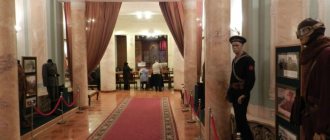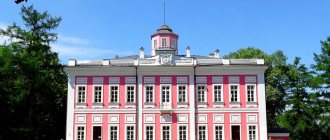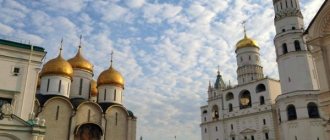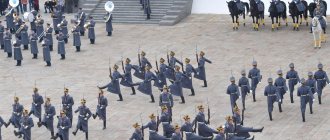Surprisingly, there is only one museum of jewelry art in Moscow. But what a one! Unmatched in the whole world. Its name is the Diamond Fund. Here, without exaggeration, are presented the most unique collections of rare precious stones, nuggets of precious metals, semi-precious gems, jewelry of the imperial family and order badges. Each exhibit is a masterpiece. Everyone has their own story. Just think, if things really have memory, how long do these objects remember...
The foundation's collection includes about 70 items. It’s impossible to list everything. Such beauty cannot be described in words. The treasury attendants joke: be sure to bring sunglasses on the excursion so as not to be blinded by the shine of the precious stones. In general, definitely - see with your own eyes. Well, we will tell you about the most valuable exhibits.
Imperial symbols of power
The Great Imperial Crown of the Russian Empire is decorated with 4,936 diamonds, 75 Indian matte pearls and a bright red spinel. The weight of the product is almost 2 kg.
The small imperial crown is inlaid with 48 large and 200 small diamonds. Although there were other similar crowns in Tsarist Russia, this is the only one that has survived. Such tiaras were dismantled after the death of the owner-empress, and the precious stones were inherited in accordance with the will.
Among the numerous diamonds of the golden scepter, the Orlov diamond is especially famous. Empress Catherine II named it so in honor of her favorite Grigory Orlov.
The perfectly smooth surface of the orb is decorated with a large sapphire located under an openwork cross, a completely clear diamond with a bluish tint in the center and a diamond belt.
Login to the site
The Diamond Fund is located in the building of the Armory Chamber
The Diamond Fund of the Russian Federation is an integral part of the State Fund of Precious Metals and Precious Stones of the Russian Federation, which is a collection of unique nuggets of precious metals and unique precious stones of historical and artistic significance, as well as a collection of unique jewelry and other products made of precious metals and precious stones.
The collection began to take shape back in the 18th century, when Peter I issued a special decree on the preservation of things “subject to the state,” thereby recognizing that the most significant of them should be the property not only of the royal family, but of the entire Russian state. Precious items of state regalia, insignia and secular decorations of many generations of Russian autocrats until 1914 were kept in a special Diamond Cabinet of the Winter Palace (Imperial Renteria).
According to the Tsar's Decree, all coronation regalia were to be kept in the treasury in a chest with three locks and be the property of the state (All valuables were in St. Petersburg). It could be opened only if necessary. Moreover, all three key keepers, and each had only one key, had to get together. Only then could state relics be obtained.
Later, a chamber was built to store valuables, which was called the Diamond Fund, then it was renamed the Diamond Room. The boyars who guarded it were responsible for its safety with their heads.
In 1914, with the outbreak of the First World War, the historical values of the Diamond Room were urgently evacuated from Petrograd to Moscow, to the Kremlin Armory. Their analysis and accounting were carried out after the October Revolution. In 1922, the jewelry was transferred to the State Repository of Valuables (Gokhran), which in 1924 was renamed the Diamond Fund of the USSR, and since 1991, the Diamond Fund of Russia. The permanent exhibition of the Diamond Fund has been open in the Moscow Kremlin since 1967.
Currently, the exhibition is located in two huge halls. In the first hall there are two showcases. One of them presents unique jewelry, orders, precious and semi-precious gems from all over the country. In the second showcase there is a map of the former USSR made from precious stones. Giant diamonds, gold and platinum nuggets are also presented here. The exhibition also includes jewelry by contemporary masters.
The second hall is entirely dedicated to historical values. It should be noted that it is more popular among visitors. Here are the imperial symbols of power. Particularly valuable among them are the crown, scepter and orb. The Diamond Fund is considered the richest museum in Russia. The museum has several exhibitions and a visit begins with a visit to the display case with natural diamonds. All diamonds weighing more than 50 carats go to the Diamond Fund. Further on in the exhibition are 7 historical stones from the Diamond Fund:
DIAMOND “50 YEARS OF THE USSR” (71.50 carats. “Mir” pipe) There are diamonds in the treasury “Maria” (105.98 carats), “Chekist” (95.0 carats), “Olympiad - 80” (black crystal weighing 101.11 carats), “XXVI Congress of the CPSU” (the largest in the collection – 342.57 carats), “Star of Yakutia” (232 carats). By the way, there is a funny story connected with his name. At that time, only the head of government could become the “Godfather” of a unique diamond - it was customary that large crystals were necessarily delivered to the bride’s office in the office of the Chairman of the Council of Ministers, Alexei Kosygin. But in those days, Alexey Nikolaevich was on vacation, and the stone was hastily named “50 years of Aeroflot.”
DIAMOND “THE GREAT BEGINNING” (135.12 carats. “Mir” pipe) With this name, the stone immediately entered the illustrated catalog of the De Beers diamond empire in London. Kosygin, who returned from vacation, rejected the name and suggested calling the diamond more sonorously - “Star of Yakutia.” And De Beers, they say, if it wants, will rewrite its registers under a new name... Nowadays, the principles of naming unique stones have changed little. One large Yakut diamond was given the name “Akademik Zhores Alferov”. The management of the largest Russian diamond mining company decided in this way to “celebrate the contribution of the Russian scientist, Nobel Prize winner, to the development of domestic and world science.”
URSA BIG DIAMOND (114.37 carats)
DIAMOND “PROGRESS” (80.66 carats. “Mir” pipe) diamond “Orlova” (named after Count Orlov) – 189.62 carats diamond “Shah” – 88.7 carats
flat portrait diamond - 25 carats giant spinel (a type of ruby) - 398.72 carats giant emerald - 136.25 carats giant Ceylon sapphire - 258 carats giant olive green peridot - 192.6 carats - the largest in the world
Exhibit: Hat
This miniature openwork doll hat was made in the 1770s. The feathers of the cap are lined with diamonds and emeralds. The laurel branch is made of diamonds and gold, covered in places with green enamel. The luxury of color is emphasized by a magnificent briolette diamond against the background of the branch. The lush bow is set with emerald. Product size 8 x 6.5 x 4 cm. Bow-slavage
“Sklavazh” translated means a small necklace. Such jewelry was worn on a wide lace ribbon or velvet. This slavage is a lush bow, the frame of which is made of gold and silver, which is practically invisible, since it is completely lined with diamonds and spinel. Spinels are a group of minerals that include alexandrite and chrysoberyl. The uniqueness of this product lies in the fact that, thanks to the wavy line and rounded cut of the diamonds, the rather massive slavage looks openwork and light, and not stone. The stones that make up the bow have naturally light shades, but when placed on foil by the master, they acquired a bright red, rich and rich color. The item is signed “Pfisterer. April 10, 1764.” Unfortunately, there is no more detailed information about the jeweler, all that is known is that he worked in St. Petersburg. He also made earrings in the form of a bow, which together with the slavage make up the set. The product measures 11.5 x 11 cm. Great Imperial Crown The Great Imperial Crown of the Russian Empire is the main symbol of the power of the Russian monarchs. Imperial regalia from 1762 to 1917. All emperors in Russia, starting with Catherine II the Great, were crowned with the Great Imperial Crown. The crown is a masterpiece of world jewelry art.
The imperial crown was made by court jeweler Georg-Friedrich Eckart and diamond craftsman Jeremiah Pozier for the coronation of Empress Catherine II in 1762. The crown was created in record time - just two months. The work on creating the crown was supervised by jeweler G.-F. Eckart. He created the sketch and frame. The selection of diamonds was carried out by I. Pozier. The unique monument of jewelry art was restored in 1984. Chief artist V. G. Sitnikov, jewelers - V. V. Nikolaev, G. F. Aleksakhin. The restoration work time is 454 hours. It was made for the coronation of Catherine II and was subsequently used at all subsequent coronations. The weight of the crown is 1907 grams, it contains 4936 diamonds with a total weight of 2858 carats, under the diamond cross is a dark red spinel, purchased by order of Tsar Alexei Mikhailovich in China. Large bouquet
The size of the product is so large - 16 X 21 cm. Made of gold and silver, Brazilian diamonds weighing a total of 140 carats and Colombian emeralds weighing 50 carats. A 15-carat soft purple pure diamond is inserted into the openwork frame of the bud. The bouquet amazes with the variety of color nuances and the naturalness of the composition, which speaks of the highest art of an unknown jeweler. Diamond diadem of Empress Elizabeth Alekseevna, wife of Emperor Alexander I.
The manufacture of the tiara dates back to approximately 1810. The author of the dress is not known, but according to sources from those times, it was made of “175 diamonds and 1200 roses of pure water.” “Rose” in this case is an ancient form of cutting, in which the lower part of the mineral becomes flat; rose cut stones are called diamonds, not diamonds Imperial scepter
The imperial scepter is one of the main regalia of the monarchs of the Russian Empire. \ The scepter was made in the early 1770s for Empress Catherine II the Great. Materials used: gold, Orlov diamond, other diamonds, silver, enamel. The length of the scepter is 59.5 cm.
The smoothly polished golden surface of the scepter is intercepted by eight diamond rims, the handle is embossed with flutes (vertical grooves), enhancing the play of chiaroscuro. The scepter is completed by a cast gold double-headed eagle - the coat of arms of the Russian Empire, decorated with black enamel and diamonds. The pomp of this emblem of monarchical power was enhanced by the luxurious Orlov diamond, which decorated the scepter of Catherine II with her coronation regalia in 1774. The Empress holds the Scepter in her right hand. Portrait of Alexei Antropov, 1765. The scepter with which Empress Catherine II was crowned has not survived. This is a later piece, made in the early 1770s, consisting of three smooth gold pieces separated by diamond bands. In 1774, the decoration of the scepter was supplemented by decorating its upper part with a giant greenish-bluish diamond. It weighs 189.62 carats and has 180 facets. The stone is known as "Orlov". Many legends are associated with the appearance of this stone in Russia, but be that as it may, Catherine II named the stone in honor of her favorite Grigory Orlov and ordered the scepter to be decorated with it. Small Imperial Crown
Crown of Elizabeth Alekseevna. Woven from diamond lace in a silver frame, it contains 48 large and 200 small diamonds, it weighs 378 grams. Bracelet with a portrait of Emperor Alexander I
The portrait of the monarch is not under glass, but under a diamond, which gives the product special value. This is a portrait diamond, a very rare stone, so as not to distort the image placed under it, it must be very smooth and unclouded. In this product, this is a record holder among similar ones, a fragment of a very large crystal: thickness - 2.5 mm, area - 7.5 cm2, weight about 25 carats. The beautifully crafted stone emphasizes the Gothic stylization of the bracelet with its somewhat irregular triangular shape. The author and owners of the product are unknown. The portrait miniature of Alexander I is a copy of a famous portrait by the English artist Charles Dow, who arrived in Russia only at the beginning of 1819. Imperial power
The Imperial Power (also the “Tsar’s Apple”) is one of the main regalia of the monarchs of the Russian Empire. Symbol of imperial power. The orb was made in 1762 for the coronation of Empress Catherine II the Great by court jeweler Georg-Friedrich Eckart.
The imperial power acquired its modern appearance only under Emperor Paul I. A huge sapphire appeared under the cross, and a large diamond appeared in the center of the diamond belts. Materials used: gold, diamonds, sapphire, diamond, silver. Between the openwork diamond cross and the half-hoop, a huge sapphire measuring 200 carats is placed, surrounded by diamonds. At the junction of the half-hoop with the belt there is a large diamond of 46.92 carats, a completely clean stone with a bluish tint. The height of the orb with a cross is 24 cm. The circumference of the ball is 48 cm. Diamond “Shah”
The stone has practically retained its natural shape, only slightly polished on some edges. There is a groove on the stone near the top, which means it was once worn on a chain. Three inscriptions have been preserved on the diamond, the first reads: “Burkhan-Nizam Shah the second. 1000,” therefore it was made in 1595 of our calendar, when the stone belonged to the ruler of the Indian province of Ahmadnagar. In 1595, according to the European calendar, the province was captured by the Mughal troops and the stone passed to new owners, and a second inscription appears on it: “Son of Jehangir Shah Jekan Shah.” Later, the stone ends up in Persia as one of the trophies, and in 1824 it finds other owners, the inscription reads: “Lord Qajar Feth Ali Shah Sultan.” After the stone, as a result of tragic events, came to Russia, it became world famous. The events took place in Tehran on January 30, 1829, when a crowd of fanatics brutally killed the Russian ambassador, diplomat and writer A.S. Griboyedov. To hush up the scandal, an embassy headed by Prince Khozrov-Mirza went to St. Petersburg, and along with the Shah’s apologies, the diamond was handed over to Emperor Nicholas I as one of the most valuable treasures. Order of the Golden Fleece
One of the oldest and most honorable orders in the world.
Only representatives of the most ancient noble families could become knights of the order. The order was made in the mid-19th century from light gold and diamonds, it is suspended from a massive clasp of very rare Brazilian burnt tourmaline
This stone is a unique symbol of friendship between Russia and Sweden, accepted as a gift by Empress Catherine II from Gustav III, the monarch of Sweden, during his visit to St. Petersburg in 1777, shortly before the start of the Russian-Swedish war. For many years the stone was considered not a tourmaline, but a ruby. This pinkish-crimson stone is the size of a chicken egg and weighs 255.75 carats. Hairpin in the form of a cornucopia
The author of the product, Louis Duval, a Frenchman, a famous St. Petersburg jeweler, made the jewelry around 1780. Its cornucopia is covered with diamond roses, and above it seem to be hanging in the air flowers from blue water sopiters, with a total mass of 7 carats with petals made up of smaller diamonds. Product size 7.5 x 7.5 cm. Breastplate with the image of Peter I
It was awarded by special highest permission to members of the imperial family and very rarely to the highest and most honored dignitaries of the state for special services to the Fatherland. Made of gold, silver and enamel, topped with a crown with diamonds. Product size 8 x 4.5 cm. Egret
A special device, made in the form of a falling stream of a fountain, which secured ostrich feathers that adorned the hairstyles and hats of ladies in the 18th century. The artist is unknown, the manufacture of the jewelry dates back to approximately 1755-1760. The scattered diamonds, smoothly curving, fall down, ending with large sapphires, which have a special “briolette” cut, translated from French as “drop”. Product size 7.5 x 7.5 cm. Badge of the Order of St. Andrew the First-Called
The earliest among the orders of Russia, established by Peter I in 1698. This award was awarded to the highest military leaders. The first holder of the order is Admiral General Fyodor Golovin, one of the closest associates of Peter I. The ownership of the sign by Peter is also confirmed by the extraordinary luxury and richness of the item - gold, massive, generously strewn with Indian diamonds. The sign of the order depicts the crucifixion of St. Andrew, the patron saint of the Russian state, one of the first disciples of Christ, crucified by the pagans. The cross has the shape of the letter “X”, which has since been called St. Andrew’s Cross. Order of St. Andrew the First-Called Apostle
Star and badge of the Order of St. Andrew the First-Called with diamonds. From the collection of the State Historical Museum The Imperial Order of the Holy Apostle Andrew the First-Called is the first Russian order to be established, the highest award of the Russian Empire until 1917. In 1998, the order was restored as the highest award of the Russian Federation. Established in 1698 (or 1699) by Peter I and until the establishment of the Order of St. Catherine in 1714, it was the only order of the Russian Empire. The first holder of the order was diplomat Fyodor Golovin in 1699.
Badge in the form of a cross for the Order of St. Apostle Andrew the First-Called. Front (left) and back sides of the sign.
Portrait of D. V. Golitsyn in the order's attire, the sign of the Order of St. Andrew the First-Called with diamonds on the order chain and an embroidered star on the cloak. The signs of the Order of St. Andrew the First-Called consisted of: 1) a cross sign, the main image of which was St. Andrew, crucified, according to legend , on an X-shaped cross; on the four ends of the cross there are the letters: SAPR (Sanctus Andreus Patronus Russiae - Saint Andrew, the patron saint of Russia; 2) a silver eight-pointed star with the motto of the Order “For Faith and Fidelity” placed in its central medallion. The badge of the order was worn on a wide blue ribbon over the right shoulder, and the star was placed on the left side of the chest; 3) On especially solemn occasions, the sign of the order was worn on the chest on a gold figured chain covered with multi-colored enamels (see photo). The only one of all Russian orders that had a chain. Star and badge of the Order of St. Apostle Andrew the First-Called with diamonds. In total, during the existence of the order, according to various sources, from 900 to 1100 people became its cavaliers. In 1998, the order was restored in the Russian Federation. Mephistopheles (nugget ) The current version of the page has not yet been verified by experienced participants and may differ significantly from the version verified on March 5, 2012; 1 edit requires verification.
Mephistopheles is the name of a gold nugget weighing 20.25 grams, fineness 901.2. The nugget is kept in the Diamond Fund of Russia, is unique in artistic terms and is the most noticeable exhibit due to the striking similarity of the nugget’s outline with the profile of Mephistopheles. Based on the results of the examination, it was established that the nugget was not artificially processed. This nugget is the smallest in weight of all those in the Diamond Fund’s vault.
Dragonfly
Portbouquet. Gold, diamonds, enamel. Petersburg, around 1770
Olivines
JEWELRY, Silver, diamonds, mother-of-pearl.Second half of the 18th century
Emerald 136, 25 carats, diamonds, gold, silver 6.5 x 6.3 cm Second quarter of the 19th century Brooches, which came into fashion at the beginning of the 19th century, are gradually becoming the most common decoration. Not very complex in artistic design, this piece is distinguished by the natural beauty of a precious stone, the size and quality of which the 19th century jeweler attached exceptional importance to. A huge square emerald, found in the 16th or 17th century in distant Colombia, is one of the seven historical stones of the Russian Diamond Fund. According to academician A. Fersman, the stone is one of a kind: despite its large size, it is absolutely pure and transparent. Its deep color is pleasantly soothing to the eye. A diamond frame made of grape leaves and large solitaires with a sinuous contour softens the geometric shape of the emerald table and creates an elegant sparkling frame for the stone.
192.60 carats Olive green stone, transparent like a drop of spring water. It was found on the volcanic island of Zeberget in the Red Sea. This chrysolite has no equal in size and purity of water. One of the seven historical stones stored in the Diamond Fund of Russia
Diamond tiara “Russian Beauty”, decorated with 25 large drop-shaped pearls, recreated by Gokhran craftsmen in analogy with the decoration ordered in 1841 by Nicholas I for the Empress in the form of the traditional Russian headdress kokoshnik.
Diamonds, silver 8 x 6.5 cm Mid-18th century. Master I. Pozier (?) Diamond studs in the form of bows with a large stone in the center, highlighted by a small diamond edge, are interesting in design and its artistic embodiment. The jeweler places the main emphasis on stones that do not decorate, but constitute the essence of the object, trying with all his might to enhance their shine and play. One of the pins has a more complex design, where each large diamond, highlighted in relief by the jeweler, compositionally organizes the item. The whimsical curves of the narrow diamond ribbons of the other hairpin give the product a special airiness and weightlessness.
Diamonds, gold, silver, enamel 15 x 6 cm 1750s Asymmetrical composition in the Rococo style of a small diamond bouquet to decorate the corsage of a lady's dress, made up of leaves and stems of various shapes. The colorful color scheme combines the shimmering green of enamel foliage, ash-pink diamond buds, decorative flowers shimmering with a lemon-yellow sheen, and the brilliant purple of the rose sparkling with reddish reflections. The warm colors of the stone placed on the foil create the impression of a subtle movement of the bouquet.
Diamonds, gold, silver, enamel 18.8 x 8.5 cm Second half of the 18th century A bouquet of daffodils is a decoration for the corsage of a lady's dress, perhaps one of the most interesting pieces of jewelry of this kind. Smoothly curved images of daffodils, united by a common silhouette, are compositionally consistent and balanced. Flower petals lined with small diamonds sparkle with light. Highly raised yellow diamond cores emit a golden glow, sliding along the petals with soft highlights. And slightly inclined enamel leaves on a golden stem with their emerald greenery set off the delicate range of a skillfully selected stone.
Diamonds, gold, silver Length 20.5 cm Late 18th century Diamond pins apparently adorned a summer hat. Mounted on long golden rods, they sparkled above a sea of lace, ribbons and flowers. In the very shape of the openwork bobbins, in the slight helical movement of the diamond stripes, grabbed from above and below by rounded tips, one can feel the impeccable taste of the jeweler
Diamonds, gold 20.8 x 7 cm Second half of the 18th century A gold diamond epaulette was worn on the right shoulder to support the ribbon of the Order of St. Andrew the First-Called. Two rows of large diamonds unexpectedly form a light band in the form of a gently curved bow, imitating the folds of fabric. A bow, tied in the center with a large diamond, seems to flow naturally from four narrow diamond ribbons into movably fixed diamond pendants. The combination of an epaulette, shimmering with the iridescent shine of a diamond stream in a gold frame, with a ceremonial uniform embroidered with gold created an exceptional effect.
Diamonds, rubies, gold, silver 8.5 x 8.5 cm Late 18th century A semicircle with a cross was one of the signs of the Order of St. Catherine. Made by skilled jewelers, it was used to decorate ceremonial clothing, in which the ladies of the court, awarded the order, were supposed to appear at the palace on the order's holidays. The semicircle was attached to the brim of the order's hat.
Established by the Decree of the Presidium of the Supreme Soviet of the USSR dated September 2, 1940, as a sign of special distinction for persons holding the rank of Marshal of the Soviet Union. The Marshal's Star of the Marshal of the Soviet Union is a five-pointed gold star with smooth dihedral rays on the front side. Superimposed on top of the gold star is a smaller five-pointed platinum star. At the center of the platinum star is a 2.62-carat diamond. In the rays of the platinum star are 25 diamonds weighing a total of 1.25 carats. Between the edges of the rays of the golden star are 5 diamonds weighing a total of 3.06 carats. The diameter of the circumscribed circle of the gold star is 44.5 mm, the platinum star is 23 mm. The height of the Marshall star profile is 8 mm. The reverse side of the badge is flat, with openwork of platinum star diamonds and diamonds located between the edges of the rays. The total weight is 36.8 g. The Marshall star, using a triangular eyelet in the upper beam, is connected to a semi-oval mount measuring 14 mm, through which a red moiré ribbon 35 mm wide is threaded.
Diamonds, platinum 10 x 15 cm; 222, 11 1974 Artist V. Nikolaev Jewelers V. Nikolaev, G. Aleksakhin In the 70s of the last century, a jewelry laboratory appeared in Gokhran. It is known that there were five masters in those years: Viktor Nikolaev, Boris Ivanov, Vladimir Zhilin, Gennady Aleksakhin.
They were led by the hereditary jeweler Vladimir Sitnikov. These masters are the authors of almost all modern jewelry that Gokhran has.
In the boring 70s, when our women wore stamped “signets”, rings with huge artificial stones and the same poor earrings in the form of diamonds, squares and “tulips”, here artists worked miracles and created works of art.
100 works made in the style of the 19th century can be seen at the exhibition at the Diamond Fund, including the famous brooch of Viktor Nikolaev “Diamond Rose”.
They say that Gokhran employees brought armfuls of flowers to the jeweler in order to more accurately find the future image, but he spied it in Filevsky Park: someone had left a rose on a bench. A fully opened bud sways at the slightest movement, and the play of diamond scree creates the illusion of a living rose branch. Despite its significant dimensions (10 x 15 cm) and weight (222.11 g), the decoration seems light and elegant.
Diamonds, platinum, gold, pearls Artist N. Rostovtseva Jewelers B. Ivanov, G. Aleksakhin Light and elegant decoration in a modern style in the form of a garland of flowers. The bright shine of diamonds is softened by the matte shimmer of prominent pearls. Flower pendants are fixed movably. Some asymmetrical design gives the decoration a sophisticated look.
Order of St. Andrew the First-Called Apostle
Star and badge of the Order of St. Andrew the First-Called with diamonds. From the collection of the State Historical Museum The Imperial Order of the Holy Apostle Andrew the First-Called is the first Russian order to be established, the highest award of the Russian Empire until 1917. In 1998, the order was restored as the highest award of the Russian Federation. Established in 1698 (or 1699) by Peter I and until the establishment of the Order of St. Catherine in 1714, it was the only order of the Russian Empire. The first holder of the order was diplomat Fyodor Golovin in 1699. Badge in the form of a cross for the Order of St. Apostle Andrew the First-Called. Front (left) and back sides of the sign. Portrait of D. V. Golitsyn in the order's attire, the sign of the Order of St. Andrew the First-Called with diamonds on the order chain and an embroidered star on the cloak. The signs of the Order of St. Andrew the First-Called consisted of: 1) a cross sign, the main image of which was St. Andrew, crucified, according to legend , on an X-shaped cross; on the four ends of the cross there are the letters: SAPR (Sanctus Andreus Patronus Russiae - Saint Andrew, the patron saint of Russia; 2) a silver eight-pointed star with the motto of the Order “For Faith and Fidelity” placed in its central medallion. The badge of the order was worn on a wide blue ribbon over the right shoulder, and the star was placed on the left side of the chest; 3) On especially solemn occasions, the sign of the order was worn on the chest on a gold figured chain covered with multi-colored enamels (see photo). The only one of all Russian orders that had a chain. Star and badge of the Order of St. Apostle Andrew the First-Called with diamonds. In total, during the existence of the order, according to various sources, from 900 to 1100 people became its cavaliers. In 1998, the order was restored in the Russian Federation. Mephistopheles (nugget ) The current version of the page has not yet been verified by experienced participants and may differ significantly from the version verified on March 5, 2012; 1 edit requires verification. Mephistopheles is the name of a gold nugget weighing 20.25 grams, fineness 901.2. The nugget is kept in the Diamond Fund of Russia, is unique in artistic terms and is the most noticeable exhibit due to the striking similarity of the nugget’s outline with the profile of Mephistopheles. Based on the results of the examination, it was established that the nugget was not artificially processed. This nugget is the smallest in weight of all those in the Diamond Fund’s vault.
Dragonfly Portbouquet. Gold, diamonds, enamel. Petersburg, around 1770 Olivina
JEWELRY, Silver, diamonds, mother-of-pearl. Second half of the 18th century Emerald 136, 25 carats, diamonds, gold, silver 6.5 x 6.3 cm Second quarter of the 19th century Brooches, which came into fashion at the beginning of the 19th century, are gradually becoming the most common decoration . Not very complex in artistic design, this piece is distinguished by the natural beauty of a precious stone, the size and quality of which the 19th century jeweler attached exceptional importance to. A huge square emerald, found in the 16th or 17th century in distant Colombia, is one of the seven historical stones of the Russian Diamond Fund. According to academician A. Fersman, the stone is one of a kind: despite its large size, it is absolutely pure and transparent. Its deep color is pleasantly soothing to the eye. A diamond frame made of grape leaves and large solitaires with a sinuous contour softens the geometric shape of the emerald table and creates an elegant sparkling frame for the stone. 192.60 carats Olive green stone, transparent like a drop of spring water. It was found on the volcanic island of Zeberget in the Red Sea. This chrysolite has no equal in size and purity of water. One of the seven historical stones stored in the Diamond Fund of Russia is the “Russian Beauty” diamond tiara, decorated with 25 large drop-shaped pearls, recreated by Gokhran craftsmen by analogy with the decoration ordered in 1841 by Nicholas I for the Empress in the form of the traditional Russian headdress kokoshnik. Diamonds, silver 8 x 6.5 cm Mid-18th century. Master I. Pozier (?) Diamond studs in the form of bows with a large stone in the center, highlighted by a small diamond edge, are interesting in design and its artistic embodiment. The jeweler places the main emphasis on stones that do not decorate, but constitute the essence of the object, trying with all his might to enhance their shine and play. One of the pins has a more complex design, where each large diamond, highlighted in relief by the jeweler, compositionally organizes the item. The whimsical curves of the narrow diamond ribbons of the other hairpin give the product a special airiness and weightlessness. Diamonds, gold, silver, enamel 15 x 6 cm 1750s Asymmetrical composition in the Rococo style of a small diamond bouquet to decorate the corsage of a lady's dress, made up of leaves and stems of various shapes. The colorful color scheme combines the shimmering green of enamel foliage, ash-pink diamond buds, decorative flowers shimmering with a lemon-yellow sheen, and the brilliant purple of the rose sparkling with reddish reflections. The warm colors of the stone placed on the foil create the impression of a subtle movement of the bouquet. Diamonds, gold, silver, enamel 18.8 x 8.5 cm Second half of the 18th century A bouquet of daffodils is a decoration for the corsage of a lady's dress, perhaps one of the most interesting pieces of jewelry of this kind. Smoothly curved images of daffodils, united by a common silhouette, are compositionally consistent and balanced. Flower petals lined with small diamonds sparkle with light. Highly raised yellow diamond cores emit a golden glow, sliding along the petals with soft highlights. And slightly inclined enamel leaves on a golden stem with their emerald greenery set off the delicate range of a skillfully selected stone.
Diamonds, gold, silver Length 20.5 cm Late 18th century Diamond pins apparently adorned a summer hat. Mounted on long golden rods, they sparkled above a sea of lace, ribbons and flowers. In the very shape of the openwork bobbins, in the slight helical movement of the diamond stripes, grabbed from above and below by rounded tips, one can feel the impeccable taste of the jeweler Diamonds, gold 20.8 x 7 cm Second half of the 18th century A gold diamond epaulette was worn on the right shoulder to support the ribbon of the Order of St. Andrew the First-Called. Two rows of large diamonds unexpectedly form a light band in the form of a gently curved bow, imitating the folds of fabric. A bow, tied in the center with a large diamond, seems to flow naturally from four narrow diamond ribbons into movably fixed diamond pendants. The combination of an epaulette, shimmering with the iridescent shine of a diamond stream in a gold frame, with a ceremonial uniform embroidered with gold created an exceptional effect. Diamonds, rubies, gold, silver 8.5 x 8.5 cm Late 18th century A semicircle with a cross was one of the signs of the Order of St. Catherine. Made by skilled jewelers, it was used to decorate ceremonial clothing, in which the ladies of the court, awarded the order, were supposed to appear at the palace on the order's holidays. The semicircle was attached to the brim of the order's hat. Established by the Decree of the Presidium of the Supreme Soviet of the USSR dated September 2, 1940, as a sign of special distinction for persons holding the rank of Marshal of the Soviet Union. The Marshal's Star of the Marshal of the Soviet Union is a five-pointed gold star with smooth dihedral rays on the front side. Superimposed on top of the gold star is a smaller five-pointed platinum star. At the center of the platinum star is a 2.62-carat diamond. In the rays of the platinum star are 25 diamonds weighing a total of 1.25 carats. Between the edges of the rays of the golden star are 5 diamonds weighing a total of 3.06 carats. The diameter of the circumscribed circle of the gold star is 44.5 mm, the platinum star is 23 mm. The height of the Marshall star profile is 8 mm. The reverse side of the badge is flat, with openwork of platinum star diamonds and diamonds located between the edges of the rays. The total weight is 36.8 g. The Marshall star, using a triangular eyelet in the upper beam, is connected to a semi-oval mount measuring 14 mm, through which a red moiré ribbon 35 mm wide is threaded. Diamonds, platinum 10 x 15 cm; 222, 11 1974 Artist V. Nikolaev Jewelers V. Nikolaev, G. Aleksakhin In the 70s of the last century, a jewelry laboratory appeared in Gokhran. It is known that there were five masters in those years: Viktor Nikolaev, Boris Ivanov, Vladimir Zhilin, Gennady Aleksakhin. They were led by the hereditary jeweler Vladimir Sitnikov. These masters are the authors of almost all modern jewelry that Gokhran has. In the boring 70s, when our women wore stamped “signets”, rings with huge artificial stones and the same poor earrings in the form of diamonds, squares and “tulips”, here artists worked miracles and created works of art. 100 works made in the style of the 19th century can be seen at the exhibition at the Diamond Fund, including the famous brooch of Viktor Nikolaev “Diamond Rose”. They say that Gokhran employees brought armfuls of flowers to the jeweler in order to more accurately find the future image, but he spied it in Filevsky Park: someone had left a rose on a bench. A fully opened bud sways at the slightest movement, and the play of diamond scree creates the illusion of a living rose branch. Despite its significant dimensions (10 x 15 cm) and weight (222.11 g), the decoration seems light and elegant. Diamonds, platinum, gold, pearls Artist N. Rostovtseva Jewelers B. Ivanov, G. Aleksakhin Light and elegant decoration in a modern style in the form of a garland of flowers. The bright shine of diamonds is softened by the matte shimmer of prominent pearls. Flower pendants are fixed movably. Some asymmetrical design gives the decoration a sophisticated look.
Source: https://blog.kp.ru/users/smile557780/post245285302/
Large bouquet
The product is decorated with an unusual soft purple diamond of natural origin, placed in an open iris bud. It is worth noting that this is the only colored diamond in the bouquet. Thin plates of multi-colored foil are placed under the remaining diamonds, which creates a multi-color effect. In addition, flowers and leaves are attached to springs. At the slightest breath of wind, the flowers tremble, sway and look just like life.
Design "Order of St. Andrew the First-Called Apostle"
The order shown on silver coins includes two components - an outer radiant star and an inner beveled cross with a saint crucified on it. This insignia was placed on a blue satin ribbon slung over the left shoulder. Sometimes a chain with enamel decorations of various colors was used for this. The sign was attached to the left side of the chest.
The insignia depicted on the coins of the “Russian Diamond Fund” series was also decorated with two circles of 26 and 23 diamonds. It depicted two branches of a laurel, and included the motto “For faith and fidelity.”
The order became the very first such award in Russia. It was given for special distinctions in civil and military service by decree of the emperor himself. This insignia was established in 1698 by Peter I. Each subsequent Russian ruler received the order automatically upon coronation.
For successes in war and diplomacy, Fyodor Golovin was one of the first to be awarded this badge. The 6th and 7th holders of the order were Tsar Peter I himself and his assistant Alexander Menshikov for boarding two Swedish warships in the Neva estuary.
Under Tsar Paul the First, a tradition arose of presenting this high award to the infants of the Grand Dukes during their baptism ceremony. The children were tied with a blue ribbon. The tradition passed down to the people and has survived to this day. Now many newborns, when taken home from the maternity hospital, are tied with a symbolic bow of the same color.
The presentation of this award was canceled after the victory of the October Revolution of 1917, and was resumed in 1998.
Tiara “Russian Beauty”
The exhibition features a masterful replica of this incomparable work of art. The fate of the original is a mystery, shrouded in darkness. In 1987, a group of jewelers and artists recreated the tiara based on surviving images and descriptions of it in historical sources. To make a copy it took platinum, 25 pearls and 1,000 diamonds. A truly worthy decoration for every Russian beauty. Product weight is about 400 g.
Working hours of the Diamond Fund in 2021
- The Diamond Fund occupies two halls in the building of the Armory Chamber of the Moscow Kremlin;
- The Diamond Fund's operating hours are from 10:00 to 18:15. Lunch - from 13:00 to 14:00. Visiting sessions are every 20 minutes. Last show at 17:20
- Thursday - day off
- The ticket office is open from 9:00 to 16:30, break from 12:00 to 13:00. Please note that in summer and on weekends there are especially many people who want to visit the exhibition. Sale of tickets for the first half of the day begins at 9:00, sale of tickets for the second half of the day at 13:00. Therefore, if you want to be guaranteed to get into the Diamond Fund, you need to go to the cashier at 9:00 or 13:00.
- It is possible to book tickets on the official website.
- Tickets are sold in the Alexander Garden at the box office near the Kutafya Tower.
- Ticket booking is available for individual visitors on the official website of the Diamond Fund. This service is especially relevant in the summer, on weekends and holidays, when there are especially many people wanting to go to the museum. One visitor can book up to 4 tickets, which must be purchased at the ticket office in the Alexander Garden no later than 1 hour before the start of the tour. Otherwise, the reservation will be cancelled.
- To get to the Diamond Fund you need to go through the Borovitsky Gate. If you have just bought tickets at the ticket office near the Kutafya Tower and are facing the Kremlin wall, then you need to walk about 300 meters to the right, to the end of the Alexander Garden. You will see a large tower with a large passage - this is where workers and official delegations enter the Kremlin. You need to go through the small gate that is located nearby.
Brooch with emerald
The brooch, simple in artistic design, is distinguished by the natural beauty of a dense green emerald with a slight bluish tint. The square stone, despite its rather large size, is absolutely clean and transparent. According to experts, this emerald is the only one in the world with its impeccable characteristics. Experts believe that the stone was mined in Colombia back in the Middle Ages.
Story
Peter the Great was the first to think about creating a treasury. Until 1914, Russian emperors kept dynastic relics in the Winter Palace of St. Petersburg. With the outbreak of the global armed conflict, the valuables went to the storage room of the Armory Chamber of the Moscow Kremlin, where they remain to this day.
Petersburg period
In 1719, Peter I issued a decree establishing a Chamber College to ensure the safety of coronation items and unique dynastic jewelry.
A room (renteria) was allocated in the Winter Palace for the permanent storage of state symbols of power and jewelry of the royal family. Renteria, which means “treasury” in German, became the basis for the creation of the Russian State Fund of Precious Metals and Stones.
Renteria was locked with 3 locks. The treasury could be opened by the chamber-president, chamber-counselor, or rent master on the personal instructions of the emperor. Each of them kept a key to one of the locks. Only the simultaneous presence of all 3 responsible persons made it possible to get into the storage room.
At the end of the solemn or festive ceremony, the jewelry was returned to the renteria. The vault later became known as the Diamond Room. The collection of valuables was replenished through acquisitions from the treasury and gifts to monarchs.
The most significant number of unique items was obtained during the reign of Catherine II. Having become empress, she ordered her bedroom and the adjacent chambers to be converted into the Diamond Room. All yard valuables have been marked, measured and entered into the register.
After the death of Catherine, the room became part of the individual apartments of Maria Feodorovna herself, the wife of Paul I. Under Nicholas I, the special storage room was again transferred to the official category. A distinction arose between the personal collection property of the emperor and the state property.
Moscow period
With the outbreak of international confrontation, the valuables of the Diamond Room were taken to Moscow for storage. Despite the urgent evacuation, an inventory dated 1898 was attached to each box. After 6 years, the royal treasures were transferred to Gokhran - which means a repository of valuables, according to Lenin’s instructions.
In 1922 The established commission compiled an inventory of items taken from the Winter Palace at the beginning of the war, and determined their significance for further storage. On this basis, the sale of unique items began, as meaning nothing for the history of the new state.
In 1925 Gokhran listed 773 items. From 1925 to 1936, a significant part of the collection of jewelry was sold by government decision or stolen. In 1936, Stalin imposed a ban on the seizure of treasures. The exhibition began on a regular basis in the late 60s of the 20th century.
Modernity
The Diamond Fund owns in its collection 114 items that have not only artistic but also historical value. All museum exhibits are indivisible state property and are not subject to transfer to any persons or states. Used for scientific and educational purposes within the Moscow Kremlin. The decision to exclude from the collection is made by decree of the President. Responsibility for the safety of treasures lies with the Ministry of Finance of the Russian Federation.
Coin design with bow-slavage
A small necklace worn high on the neck was called a sklavage. It was secured on a wide silk or lace ribbon, and optionally supplemented with threads of pearls. In the 60s of the 18th century, the fashion for this decoration came to Russia from France.
At this time, several cutting factories were opened, and numerous jewelry craftsmen were invited from abroad. The courtiers bathed in luxury and competed with each other with the richness of their jewelry. The fashion for cheaper jewelry also spread among the less titled classes.
The clavage shown on these silver coins appears to be a bow attached to a silver and gold frame. It was decorated with precious stones weighing a total of 150 carats. The owner of the item was Catherine the Great herself.
The First World War forced the royal family to move their relics from St. Petersburg to Moscow. The removal of valuables was carried out hastily. Things weren't carefully rewritten. The boxes with them lay in the Kremlin Armory until 1922, when the Bolsheviks began inventorying them. The slavage bow of Empress Maria Feodorovna was discovered as part of these jewelry.
Silver coins “Portbouquet”
The fifth decoration in the “Russian Diamond Fund” series is a portobouquet. The specific item shown on these silver coins was manufactured in 1770. It consists of green-enameled gold stems entwined with a ribbon of diamonds. There is a diamond inlay bow at the top and a loose tassel pendant.
The fashion for these accessories was brought to Russia from European countries. In fact, the decoration can be used as a miniature hanging flower vase, attached like a brooch to the bodice. Live inflorescences were placed in a portobouquet to protect expensive clothes from damage and stains.
The relic placed on these coins of the “Diamond Fund of Russia” series could belong to Elizaveta Alekseevna, the wife of Alexander the First, or Maria Feodorovna, the wife of Emperor Paul the First.











